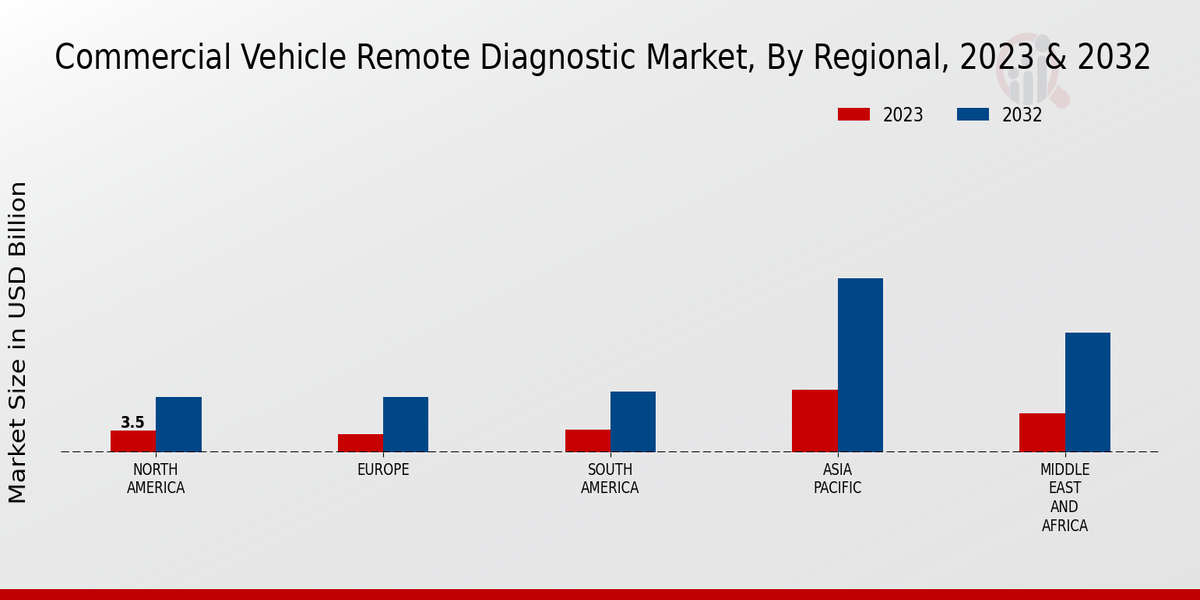Increased Focus on Sustainability
The Global Commercial Vehicle Remote Diagnostic Market Industry is witnessing a heightened focus on sustainability and environmental responsibility. As companies strive to reduce their carbon footprint, remote diagnostics play a crucial role in optimizing fuel efficiency and minimizing emissions. By utilizing real-time data, fleet operators can make informed decisions that enhance vehicle performance while adhering to environmental regulations. This trend aligns with global initiatives aimed at promoting sustainable transportation solutions. The market's growth trajectory, from 17.3 USD Billion in 2024 to 68.9 USD Billion by 2035, suggests that sustainability is becoming a key driver in the adoption of remote diagnostic technologies.
Technological Advancements in Diagnostics
The Global Commercial Vehicle Remote Diagnostic Market Industry is experiencing rapid technological advancements, particularly in telematics and IoT integration. These innovations enhance vehicle monitoring capabilities, allowing for real-time data collection and analysis. For instance, advanced diagnostic tools can now predict potential failures before they occur, thereby reducing downtime and maintenance costs. As a result, the market is projected to grow from 17.3 USD Billion in 2024 to 68.9 USD Billion by 2035, reflecting a compound annual growth rate of 13.38% from 2025 to 2035. This trend underscores the increasing reliance on technology to optimize fleet management and operational efficiency.
Regulatory Compliance and Safety Standards
The Global Commercial Vehicle Remote Diagnostic Market Industry is influenced by stringent regulatory compliance and safety standards imposed by governments worldwide. These regulations necessitate the implementation of advanced diagnostic systems to ensure vehicles meet safety and environmental standards. For example, the European Union has established regulations that require real-time monitoring of emissions and vehicle performance. As a result, companies are increasingly adopting remote diagnostic technologies to comply with these regulations, thereby driving market growth. The anticipated increase in market size from 17.3 USD Billion in 2024 to 68.9 USD Billion by 2035 reflects the industry's response to these regulatory pressures.
Rising Demand for Fleet Management Solutions
The Global Commercial Vehicle Remote Diagnostic Market Industry is driven by the escalating demand for effective fleet management solutions. Companies are increasingly seeking ways to enhance operational efficiency and reduce costs associated with vehicle maintenance. Remote diagnostics facilitate proactive maintenance strategies, allowing fleet operators to address issues before they escalate into costly repairs. This shift towards preventive maintenance is expected to contribute significantly to market growth, as organizations recognize the value of minimizing vehicle downtime. The projected growth from 17.3 USD Billion in 2024 to 68.9 USD Billion by 2035 indicates a strong market response to these evolving demands.
Growing Adoption of Electric and Hybrid Vehicles
The Global Commercial Vehicle Remote Diagnostic Market Industry is significantly impacted by the growing adoption of electric and hybrid vehicles. As these vehicles become more prevalent, the need for specialized diagnostic tools that cater to their unique systems and components is increasing. Remote diagnostics enable fleet operators to monitor battery health, charging cycles, and overall vehicle performance, which is essential for maintaining operational efficiency. This trend is likely to accelerate market growth, as the transition to electric and hybrid vehicles necessitates advanced diagnostic capabilities. The projected market expansion from 17.3 USD Billion in 2024 to 68.9 USD Billion by 2035 highlights the importance of adapting to these evolving vehicle technologies.























